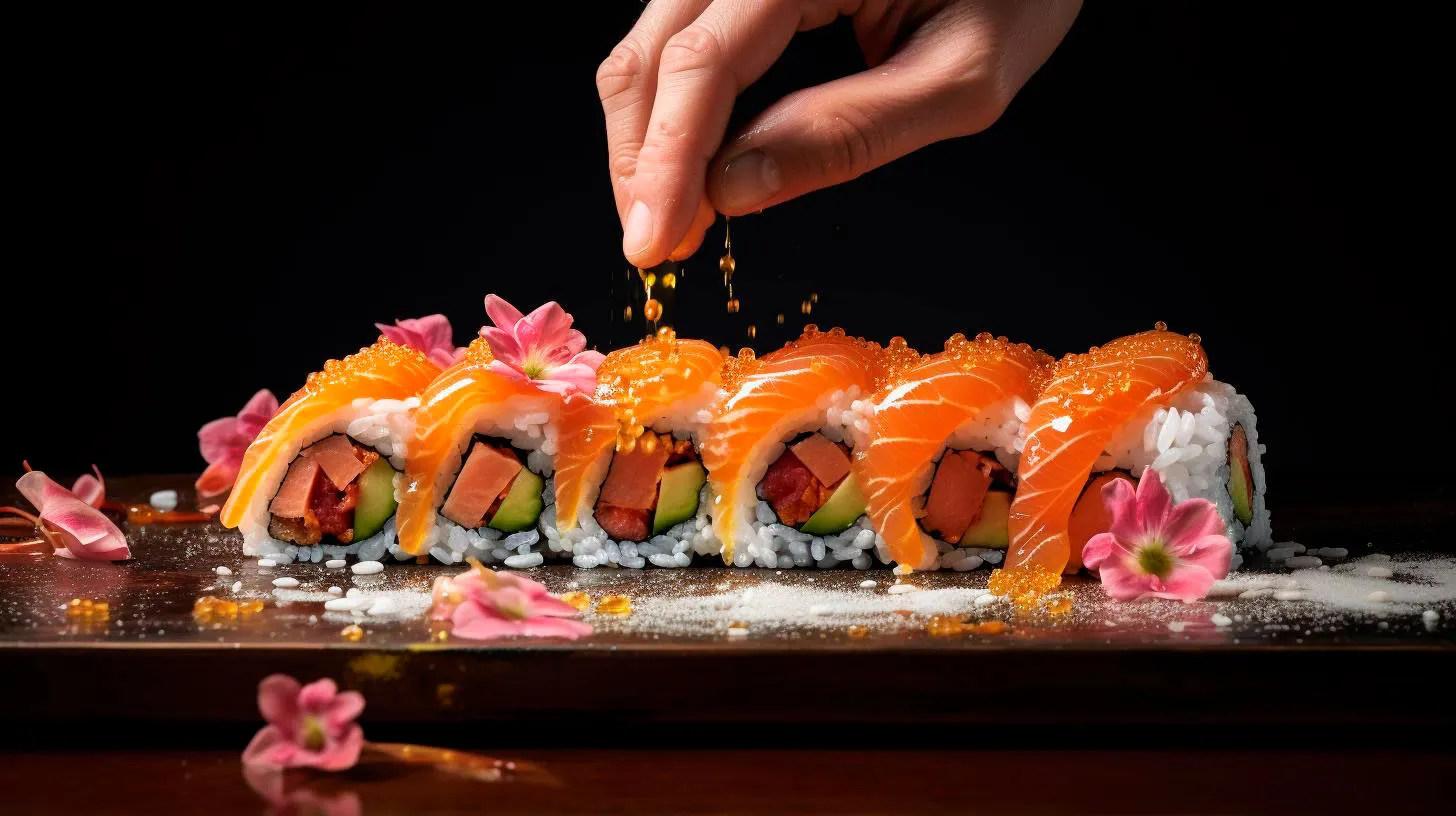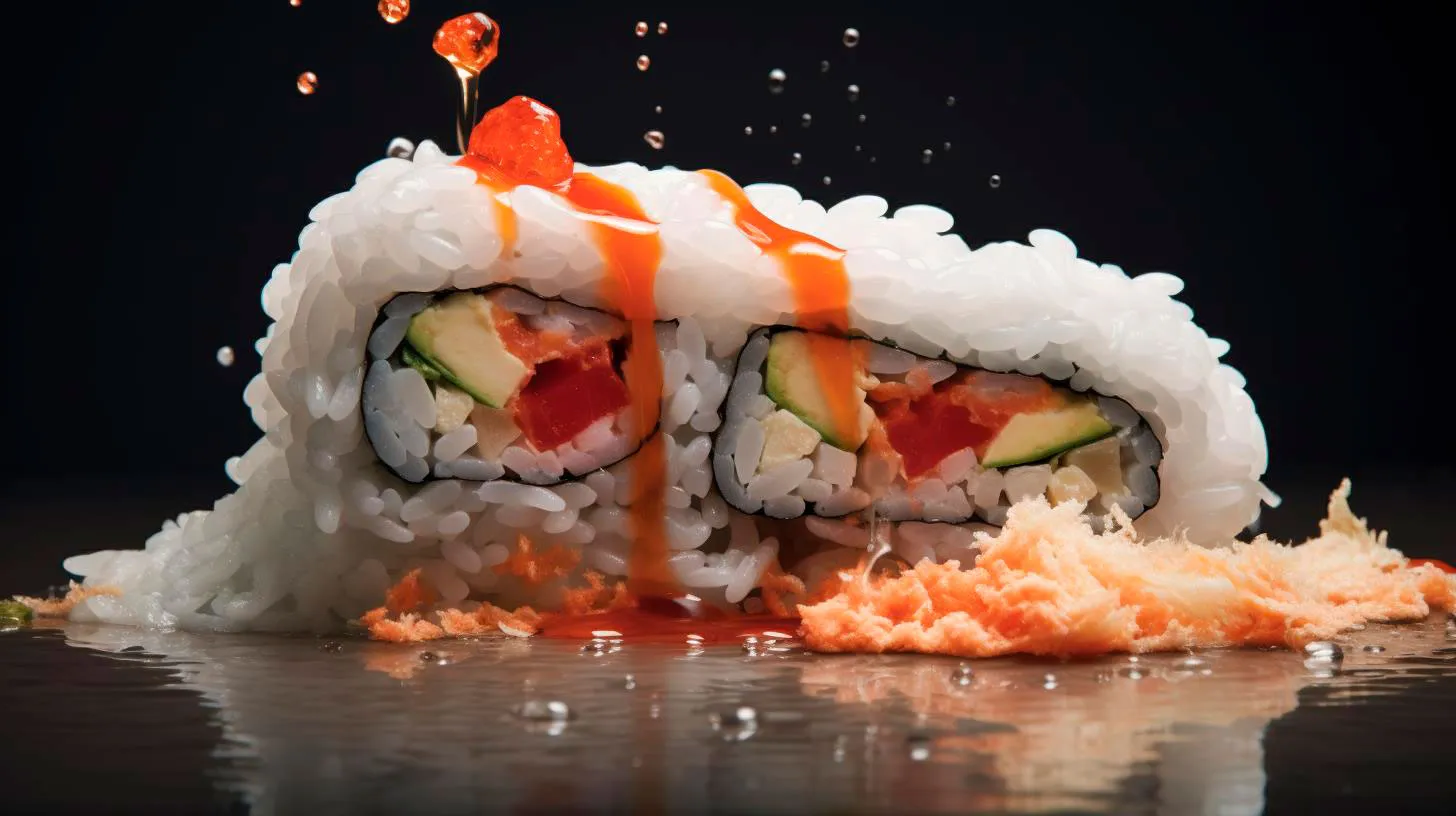Preserving Culinary Legacy: Sushi’s Role in Cultural Heritage
Sushi is not only a delicious food but also a symbol of the country’s rich heritage, making it vital to safeguard its legacy for future generations.
The Rich History of Sushi
Sushi, a type of Japanese cuisine characterized by vinegared rice combined with a variety of ingredients like raw or cooked seafood, vegetables, and sometimes tropical fruits, traces its origins back to the 8th century. Initially, sushi was developed as a means to preserve fish by fermenting it with rice, rather than as the raw delicacy we know today. Over the centuries, sushi evolved, and different regional styles emerged.
Sushi became popular in the Edo period (1603-1868) when Yohei Hanaya, a talented sushi chef, created the nigiri style we are familiar with today. This period marked the birth of modern sushi and the establishment of sushi restaurants, known as sushi-ya. Since then, sushi has gained global recognition and has become a favorite dish worldwide.
Sushi’s Cultural Significance
Sushi is not merely a food item but also an embodiment of various cultural aspects. It reflects the values and traditions deeply ingrained in Japanese society. Here are a few ways sushi contributes to cultural heritage:
- Traditional Craftsmanship: The art of sushi making requires precision, skill, and years of training. It is passed down from master sushi chefs to apprentices, ensuring the preservation of this culinary craftsmanship. Sushi-making techniques like knife skills, rice preparation, and ingredient selection are considered paramount, emphasizing the importance of attention to detail.
- Seasonality and Sustainability: Sushi embodies the concept of seasonality, with various ingredients being carefully selected to harmonize with nature’s offerings. The emphasis on using sustainable seafood highlights the respect for the environment and responsible fishing practices.
- Dining Etiquette: Traditional Japanese dining etiquette surrounds sushi consumption. From the proper way to hold chopsticks to the correct order of eating sushi pieces, every aspect is rooted in respectful behavior. This adherence to etiquette reflects the discipline and respect ingrained within Japanese culture.
Preservation Efforts for Sushi’s Legacy
As sushi continues to gain popularity worldwide, efforts to preserve its cultural legacy have become crucial. Here are some initiatives aiming to ensure the longevity of sushi’s heritage:
- Designation of Traditional Sushi Restaurants: The Japanese government has designated certain sushi restaurants as “intangible cultural heritage.” These establishments follow traditional techniques and maintain the authenticity of sushi-making. This recognition helps safeguard the craftsmanship and practices associated with sushi.
- Training Programs: Various organizations and institutions offer training programs for sushi chefs, enabling them to learn and preserve traditional techniques. These programs focus on passing on skills, knowledge, and culture to the new generation, ensuring the longevity of the art.
- Preserving Local Sushi Styles: Regional sushi styles, such as Osaka’s battera sushi or Tokyo’s edomae-zushi, are being protected and promoted. By celebrating these unique variations, the diversity within sushi culture is preserved, preventing it from being homogenized.
The Global Phenomenon of Sushi
Sushi has become a global culinary sensation, transcending cultural boundaries. The widespread popularity of sushi can be attributed to several factors:
- Health Benefits: Sushi is often perceived as a healthy food choice due to its emphasis on fresh ingredients and minimal use of oil and fats. The utilization of raw fish, which is rich in omega-3 fatty acids, further adds to its health appeal.
- Accessibility: With the advent of global trade, sushi ingredients are readily available in various parts of the world, making it easier for restaurants to offer this delectable cuisine. Sushi’s accessibility has allowed people from diverse backgrounds to enjoy and appreciate its unique taste.
- Culinary Fusion: Sushi’s adaptability has led to the emergence of fusion sushi, incorporating ingredients and techniques from different cultures. This blend of culinary influences has attracted a wide range of food enthusiasts, ensuring its continuous evolution.
The Key Takeaway
Sushi’s role in cultural heritage extends beyond being a delicious dish. It encapsulates centuries of tradition, craftsmanship, and cultural values. Preserving sushi’s legacy ensures that future generations can continue to experience the rich tapestry of Japan’s culinary history. As sushi gains global recognition, efforts to safeguard its authenticity and cultural significance become even more crucial. By cherishing the art of sushi-making and celebrating its unique variations, we ensure that this culinary legacy lives on for years to come.
Behind the Scenes Food Documentaries Capturing Sushi’s Rich History
In this article, we delve into the behind-the-scenes world of food documentaries that capture sushi’s fascinating history and the key takeaways they provide.
Capturing the Artistry of Sushi
Sushi is not just a dish but an art form that requires precision, skill, and a deep understanding of the ingredients. Behind the scenes, food documentaries offer a unique perspective into the process of creating this beloved Japanese delicacy. Through stunning visuals and personal stories of sushi chefs, these documentaries allow us to witness the meticulous techniques and dedication required to craft the perfect sushi roll.
Key Takeaways:
- Sushi-making is an intricate art form that demands years of practice and experience.
- The artistry lies in the balance of flavors, textures, and presentation.
- Patience and attention to detail are paramount in achieving sushi perfection.
Preserving Tradition and Culture
Sushi has a deep-rooted history that goes beyond its delectable taste. Behind the scenes, food documentaries shed light on the cultural significance of sushi and its origins. Exploring the traditions and customs surrounding sushi-making, these documentaries help preserve the rich cultural heritage associated with this iconic Japanese cuisine.
Key Takeaways:
- Sushi has been consumed in Japan for centuries, evolving over time.
- Traditional sushi-making techniques continue to be passed down through generations.
- Sushi reflects Japanese values of simplicity, freshness, and attention to detail.
Appreciating Sustainability and Ingredients Sourcing
Behind the scenes food documentaries also delve into the aspect of sustainability and the importance of responsible sourcing when it comes to sushi ingredients. With the rise in global demand for sushi, there is a growing need to address the environmental impact of fishing practices and the sustainability of key ingredients like fish and seaweed. These documentaries highlight efforts made by sushi chefs and suppliers to ensure responsible sourcing practices.
Key Takeaways:
- Documentaries inspire conscious consumer choices by educating viewers about sustainable sourcing practices.
- Sustainably sourced ingredients help preserve marine ecosystems and support local communities.
- Championing sustainable sushi can lead to positive change in the entire seafood industry.
Exploring the Changing World of Sushi
Sushi has become a global phenomenon, transcending cultural boundaries. Behind the scenes, food documentaries provide insights into how sushi has evolved and adapted to different culinary traditions around the world. From fusion sushi incorporating flavors from other cuisines to the rise of vegan and vegetarian sushi options, these documentaries showcase the innovative ways chefs are reinventing this ancient cuisine.
Key Takeaways:
- The globalization of sushi has resulted in creative adaptations and flavor combinations.
- Sushi has become inclusive, catering to diverse dietary preferences and restrictions.
- The versatility of sushi allows for endless experimentation and culinary exploration.
The Power of Food Documentaries
Food documentaries have the uncanny ability to transport us into the world of food, sparking curiosity, and igniting our passion for different cuisines. Behind the scenes food documentaries that delve into sushi’s rich history not only entertain but also educate and foster a deeper appreciation for this beloved Japanese delicacy.
From showcasing the artistry of sushi-making to preserving cultural traditions, addressing sustainability concerns, and exploring its global evolution, these documentaries have a profound impact on our perception of sushi. They inspire us to seek out authentic sushi experiences, support sustainable practices, and celebrate the diverse flavors that sushi has to offer.
So, the next time you find yourself craving sushi, take a moment to explore the world of food documentaries that capture the essence of this ancient cuisine. You’ll be amazed at the depth of history and passion behind every bite.
From Tokyo to Your Plate: Unveiling the Secrets of Authentic Sushi
However, amidst the growing popularity, there seems to be a lack of understanding about what makes sushi truly authentic. In this article, we will take you on a journey from Tokyo to your plate, uncovering the secrets and traditions behind authentic sushi.
The Origins of Sushi
Before delving into the intricacies of authentic sushi, let’s explore its fascinating origins. Sushi can be traced back to ancient Japan, where it was initially a method of preserving fish. The earliest form of sushi, called “narezushi,” involved fermenting fish by wrapping it in fermented rice. Over time, the process evolved, leading to the development of the sushi we know today.
Fast forward to modern times, sushi has become a beloved culinary art form. In Japan, sushi chefs undergo rigorous training for years to perfect their skills and techniques. They aim to create a harmonious blend of flavors, textures, and visual appeal in each sushi creation.
The Key Elements of Authentic Sushi
Now, let’s delve into the key elements that define authentic sushi:
1. Quality of Ingredients
Authentic sushi relies heavily on the quality of its ingredients. From the fish to the rice and even the soy sauce, every component is carefully selected to ensure the highest standards. Fresh, top-notch seafood is the star of the show, and sourcing it from trusted suppliers is crucial to achieving the authentic taste and texture.
2. Sushi Rice: The Heart of Sushi
The sushi rice, known as “shari,” is the heart of sushi. It is meticulously cooked and seasoned with a delicate balance of rice vinegar, sugar, and salt. The texture and flavor of the rice play a significant role in complementing the fish or other toppings.
3. Knife Skills and Presentation
Authentic sushi requires exceptional knife skills, which are essential for creating perfect slices of fish and shaping the rice. A skilled sushi chef possesses the artistry to present sushi in an aesthetically pleasing manner. Each piece is carefully crafted to showcase the chef’s expertise and attention to detail.
4. Traditional Sushi Techniques
Sushi-making techniques have been passed down through generations, preserving the authenticity of this culinary art. From hand-pressing the rice for nigiri sushi to the precise application of wasabi, these techniques require years of practice and dedication.
The Advantages of Authentic Sushi
Now that we have explored the elements that define authentic sushi, let’s uncover the advantages it offers:
-
Health Benefits: Authentic sushi focuses on fresh, high-quality ingredients, making it a nutritious choice. Fish is an excellent source of omega-3 fatty acids, which promote heart health and improve brain function.
-
Exquisite Taste: The combination of well-seasoned rice, expertly sliced fish, and perfectly balanced flavors creates a culinary experience like no other. Each bite is a sensory delight, leaving a lasting impression.
-
Cultural Immersion: Authentic sushi allows us to immerse ourselves in Japanese culture and traditions. By embracing the art of sushi-making, we gain a deeper understanding of Japan’s rich culinary heritage.
Key Takeaways
As we conclude our journey from Tokyo to your plate, here are the key takeaways to remember:
-
Authentic sushi requires top-quality ingredients, including fresh fish, rice, and soy sauce.
-
The sushi rice, knife skills, and presentation play vital roles in creating an authentic sushi experience.
-
Traditional sushi-making techniques have been passed down through generations, preserving its authenticity.
-
Authentic sushi offers health benefits, exquisite taste, and cultural immersion.
So the next time you indulge in a plate of sushi, let the flavors transport you to the bustling streets of Tokyo, where the secrets of authentic sushi come to life.
The Art of Sushi: Exploring the Timeless Tradition
In this article, we delve into the ancient craft of sushi-making and uncover its enduring legacy.
The Origins of Sushi
The history of sushi dates back to the 8th century in Japan. Initially, it was a method of preserving fish by fermenting it with salt and rice. As time progressed, sushi evolved into an art form, balancing the flavors of rice, fish, and other accompaniments.
Key takeaways:
- Sushi originated in Japan as a means of preserving fish
- The art of sushi-making has been refined over centuries
- Balance is a crucial element in sushi flavor profiles
The Philosophy Behind Sushi
At the heart of sushi lies the philosophy of simplicity, quality ingredients, and attention to detail. The essence of sushi is to allow the natural flavors of the fish to shine, accompanied by carefully seasoned rice. Each sushi piece is meticulously crafted, balancing texture, color, and taste.
Key takeaways:
- Simplicity and quality are core principles of sushi
- Attention to detail enhances the sushi experience
- The focus is on highlighting the natural flavors of the fish
The Different Types of Sushi
Sushi comes in various forms, each with its own unique characteristics:
1. Nigiri
Nigiri sushi consists of a small mound of vinegared rice topped with a slice of raw or cooked fish. It showcases the skills of the sushi chef as they delicately form each piece by hand.
2. Maki
Maki sushi is made by wrapping rice, fish, and vegetables in seaweed or nori. The combination is then rolled tightly and sliced into bite-sized pieces. Maki rolls offer a wide variety of flavors and textures.
3. Temaki
Temaki, or hand rolls, are cone-shaped sushi rolls filled with rice, fish, and vegetables. It is meant to be eaten with the hands, providing a more interactive sushi experience.
Key takeaways:
- Nigiri showcases the chef’s precision
- Maki offers a diverse range of tastes and textures
- Temaki provides an interactive and unique sushi experience
The Role of the Sushi Chef
The art of sushi-making is entrusted to skilled sushi chefs, known as Itamae. These masters undergo years of training to perfect their technique and develop an understanding of the nuances of sushi preparation. The Itamae carefully selects the freshest ingredients, ensuring the highest quality sushi.
Key takeaways:
- Itamae are highly skilled sushi chefs
- Years of training are required to become an Itamae
- Ingredient selection is crucial for sushi quality
Sushi’s Popularity and Health Benefits
Sushi has gained immense popularity worldwide, with sushi bars and restaurants catering to a diverse range of tastes. The rise of sushi can be attributed to its unique combination of flavors, artistic presentation, and perceived health benefits.
Key takeaways:
- Sushi’s popularity has spread globally
- Artistic presentation enhances the dining experience
- Perceived health benefits attract health-conscious individuals
Conclusion
Sushi is more than a culinary delight; it is a timeless tradition that exemplifies craftsmanship and attention to detail. From its humble origins as a preservation method to its elevated status as a culinary art form, sushi continues to captivate food enthusiasts around the world. So, the next time you indulge in a plate of sushi, savor not only the flavors but also the centuries of tradition that have contributed to its creation.
Key takeaways:
- Sushi represents a centuries-old tradition
- It exemplifies craftsmanship and attention to detail
- Savor the rich history and tradition with each bite



